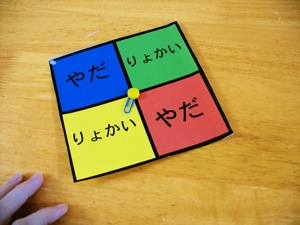

日本語
T
SS-LES-Luk 6
Story: Jesus chooses 12 disciples
Reference: Luke 6:12-16
Main point: All 12 disciples were chosen by God, 11 chose to follow God, one chose to not follow
Verse: Luke 6:12
The following ideas are grouped into categories by how they might be used in teaching the lesson. Activities to introduce the lesson would not be the same kinds of activities as those used to apply the lesson, although some of the ideas could be used in more than one category. There are several ideas for each category in the hopes that out of 3 or 4 options, one will fit your lesson and your class. So choose one activity from each category--if you try to do them all, the lesson will last for hours! Be sure to read the Bible passage before you read these suggestions, or they won’t make much sense.
Activities for Early Birds:
1. If you are going to tell the story of Matthew’s call, have the children choose pictures of foods that they would choose to make a banquet if friends were to come over to their house. Have them spread the pictures out on the table, as if it were a banquet. If several children are standing around watching, have them choose which banquet they would want to go to. Then gather up the pictures for the next child/group to choose. (You can collect free recipe cards at some grocery stores, or buy a couple of recipe books at the 100 yen store and cut them up.)
2. Make cards with the names of disciples and books of the New Testament. See if the children can guess which disciples wrote which books. You can keep them apart by writing names of disciples on one color, and books of the N.T. on a different color. (This is pretty easy, since they have the same name--Matthew wrote Matthew, Peter wrote Peter, and John wrote John and Revelation. James is believed to have been written by Jesus brother rather than the disciple.) They can check their own answers if you pair up the cards ahead of time, and mark the backs with the same mark or color. There will be a lot of cards with no match.
3. Make cards with the names of the disciples, and see if the kids can memorize all the names.
Ideas for an Introduction:
1. Ask the children if they like being chosen as a friend. Then ask them if they have ever had a friend tell them that they didn’t want to be their friend any more. Allow 1 or 2 children to tell their stories. Today’s story is about how Jesus chose 12 friends, even though he knew one of them would do something to make sure he would get caught and be killed. Pretty amazing, huh?
2. Ask them what they think a disciple is. Ask them if they think they are disciples. Tell them that a disciple is a learner.
Ideas for Teaching the Bible story:
1. This is not going to be a very interesting story if you don’t flesh it out with some other details. Some other passages you might use:
Story of Peter being called: Luke 5:1-11, 4:18-21, Mark 1:14-19, John 1:29-42
Story of Matthew being called: Luke 5: 27-31, Matt. 9:9-12, Mark 2:13-27
Story of Philip and Nathaniel: John 1:45-50
Jesus sends out 12 disciples: Matt. 10:1-40
Many disciples desert Jesus: John 6:60-70
2. Explain that Jesus chose 12 disciples who would follow him around for 3 years, listen to him teach, watch him perform miracles. For 3 years they traveled together, ate together, talked together and prayed together. Then Jesus sent them out to teach what they had learned, and to perform miracles, too. 11 disciples chose to follow Jesus to the end, but one disciple chose to stop following Jesus. In the same way, the children have to choose every day if they are going to follow Jesus or not. It may not always be easy, but Jesus always helps us do the hard things that he asks us to do.
2. If you use words like “disciple” or “betrayed,” be sure to explain the words so the children understand what you are talking about.
3. A note to draw attention to: The night before Jesus chose the disciples, he spent the night praying. We should follow Jesus example, and pray before we make important decisions.
Ideas for Reenforcement Activities:
1. Bible Stories to Color and Tell for ages 3-6 has coloring and activity pages for Peter, James, John, and Matthew, and the one for ages 6-8 has coloring and activity pages for Andrew and Peter, and Nathaniel and Philip.
2. Call out the name of each disciple, and see how many stories each team can think of for that disciple. (This game will be better if you review before hand, so you know if their answers are right, and it does require prior knowledge by the children)
3. Play “Who Am I?” Name things “you” did, and see if the kids can guess which disciple you are. (This game will be better if you review before hand, so you can quickly rattle off stories without standing there thinking a long time, or giving away the name, and it does require prior knowledge by the children) As a variation, choose 3 children who know the N.T. stories really well. Have them sit up front, facing the other children. Assign them disciple’s names, such as Peter, James, and John. Do not let them know who they are. They take turns asking the other children questions about “what they have done” to try to guess who they are. If most of the children don’t know many of the Bible stories, you can pass out information cards with the disciple’s name, and stories about him. The children up front can ask questions like, “Did I walk on water?” or “Did I sit next to Jesus at the Last supper?”
4. If you can find or draw pictures, you could make a matching game to match the pictures of stories with the disciple’s names. Bible Stories to Color is a great source for pictures. You can reduce them when you photocopy the pictures to make them more of a card size. But it you are working with a large group, it might be good to copy them big so everyone can see the pictures. An alternative idea --instead of spreading out the cards for everyone to look at, pass out one per person, and see if they can find each other.
5. 6. If you included the story of Peter’s call, you can write the verse on fish shapes for the children to color and take home, or make origami fish and glue to the paper with the verse written on it. Or write one word of the verse on each fish shape, and have the children take turns “fishing” and putting the verse in order.
6-10. Make a fish book mark, pencil stand, pencil topper, or chopsticks rest for a reminder of today’s story.
Ideas for Application:
1. Write the names of the disciples on cards. Pass them out to the children, and have them put each one under the heading, “followed Jesus to the end” or “Stopped following Jesus.” Of course, Judas is the only who would go under the “Stopped following.” Now have them write their own names on cards and put them under what they want to choose to do. Then discuss what might be things that would make them want to stop following Jesus. Examples of this might be to quit coming to church because you want to join a baseball team or soccer team and they only play games on Sunday mornings. Or they might want to quit coming to church in middle school because their friends all end up going to different schools, or after middle school quit coming to church because there isn’t a Sunday school class anymore, and church seems boring, or maybe it is embarrassing to admit that you are a christian to your friends at school.
2. Play a “Yes, Sir!” game. Explain to the children that following Jesus is not always easy. Usually it is easier to sin--like telling a lie to keep from getting in trouble. So today’s game is to practice saying, “yes” to God, even if it is a hard thing to do. The teacher names a situation and what the Bible tells us to do, (even though it is hard.) Each child listens to the situation posed by the teacher, then spins the spinner. If it lands on “Yes, Sir!” they stand, salute, and say, “Yes, Sir!” Then the next child has a turn. If it lands on “No.” the child does not stand, and play continues to the next sitting child. Everyone wins when everyone ends up standing. Because the goal is to get everyone standing in a relatively short amount of time, most of the spinner or dice spaces should have “Yes, Sir!”written on them, and fewer should have, “No” This is a probably better for a smaller group than for a large group. This game requires no skill or prior knowledge, but should get the message across to follow Jesus, even if it is hard. Some examples of situations to use for the game might be:
Even if you will get in trouble for breaking the window. tell the truth.
Even if it would be easy to put a piece of candy in your pocket, pay for it instead.
Even if you accidentally see a test answer on the next kid’s test, don’t use it.
Even if you really, really want to watch a different T.V. program than your brother, don’t fight. Work out a compromise.
Even if you want to keep watching the T.V. show till it is over, don’t pretend that you didn’t hear your mother say to take a bath.
Even if you are having fun playing with your friends outside, obey your mother, and go home on time.
Even if your friends think you are weird for doing it, be kind to the new kid in school, or the kid who is teased.
Even if you forgot to do your homework, don’t make up a story to tell your teacher.
Even if a bully hits you, don’t hit back. Instead pray for him and be kind to him.
Bow your head to pray, even if your friends ask you what you are doing.
Invite your friends to Sunday school.
Ideas for Middle school students:
If your students are familiar with many of the Gospel stories about the disciples, challenge them to think through some of the differences between Judas, and the other 11 disciples,( and if you have time, also discuss the difference between the 11, and the 3 that Jesus chose for certain events. God chooses some people to be leaders.) Then encourage them to look at themselves to see how they compare. The easiest way to do this may be to make a chart of the 12 disciples, then leave a line for the students to write their own names. This exercise is to show that although Jesus called all 12 disciples, the difference between Judas and the others, was that he chose to not follow Jesus. This is especially extraordinary because he had followed Jesus for 3 years and had learned all the same things that the other disciples learned, from God himself! Yet he chose to turn away from following God. And some of your students may choose to walk away from God at some point in their lives, The point of this chart and discussion is to impress on them that what they choose determines if they follow Jesus to the end, or if they turn away from him like Judas, and other disciples (John 6:60-70.) Warn them that there may be certain times in their lives that it will be very easy to drift away from God if they do not take precautions, such as reading the Bible and praying daily, and keeping in fellowship with other Christians in the church. No one can snatch them from God’s hand, on the other hand they alone can choose to turn away from God. You can also challenge them to think how they can do amazing things for God if they choose to do what ever he says--some of them might become leaders like the 11, and some like the 3 in the top of the chart. But God can only use people who are going to follow him whole heartedly--if they say, “No,” to God, he will set them aside and use others who always say, “Yes.”
Ideas for an Introduction:
1. Begin the lesson by talking about how colleges and companies go about choosing new people from the many applicants. Then move on to ask what they know about each disciple, and why they think God might have chosen that person. The students could work together on one one big chart on a white board, or each fill in their own chart as they listen to the discussion, or both. The chart should include both achievements and mistakes. They will soon begin to realize that there is a lot of information about Peter, and less about John, and not much at all about the other disciples. (If the students are less familiar with the Bible stories, you can provide them with Bible passages to look up, but this will take significantly more time.) There is also quite a bit about all the disciples lumped together, which can be used to list things for those who don’t have specifics about them. If this activity is used as an introductory activity, this discussion will probably need to be cut short, but you could extend the time by also using the discussion as an application activity,
2. Ask what the word, “disciple” means. Have them look up the word in a dictionary and a Bible dictionary, then make a list of all the things that makes a disciple. Ask them if they are disciples of Jesus.
Ideas for Application:
1. Make sure they fill in the chart with their names, and check off what applies to them. They may not feel like a disciple, but by coming to Sunday school, they have already begun to listen to Jesus’ teaching, and shows they have been chosen by God. Now it is up to them as to what they choose--to follow Jesus to the end--that’s one they can’t fill in yet, But each day they make choices to follow Jesus, or to say, “No.” You may want to point out how the disciples were not perfect--they sinned and made mistakes. But that did not stop God from using them. What stops God from using them is if they say, “No.”


